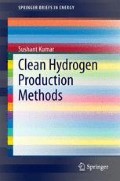Abstract
The vast depletion of fossil fuels, the increase in carbon dioxide levels in the atmosphere, and the related environmental hazards represent a growing concern for the mankind. Therefore, over the past few decades, significant efforts have been made to establish hydrogen economy. Hydrogen is a high-efficiency energy carrier, which can lead to zero or near-zero emissions at the point of use. Moreover, it has been technically shown that hydrogen can be used for transportation, heating, and power generation, and could replace current fuels in all the present applications. Besides the challenge of storing hydrogen, development of clean hydrogen production methods is considered as a prime hindrance to establish the hydrogen economy. Here, the focus is to provide a brief overview of all the processes based on both renewable and non-renewable energy sources that have been proposed to produce clean hydrogen.
Access this chapter
Tax calculation will be finalised at checkout
Purchases are for personal use only
References
US Energy Information Administration (EIA), International Energy Statistics database (as of Nov. 2013) www.eia.gov/ies.Projections: EIA, Annual Energy Outlook 2014, DOE/EIA-0383(214) (Washington, DC: April 2014) AEO 2014. National Energy Modeling System, run REF 2014.D1024BA www.eia.gov/aeo
Edigera VS, Akar S, Ugurlu B (2006) Forecasting production of fossil fuel sources in Turkey using a comparative regression and ARIMA model. Energy Policy 34:3836–3846. doi:10.1016/j.enpol.2005.08.023
Edigera VS, Akar S (2007) ARIMA forecasting of primary energy demand by fuel in Turkey. Energy Policy 35:1701–1708. doi:10.1016/j.enpol.2006.05.009
Asif M, Muneer T (2007) Energy supply, its demand and security issues for developed and emerging economies. Renew Sustain Energy Rev 11:1388–1413. doi:10.1016/j.rser.2005.12.004
Khadse A, Qayyumi M, Mahajani S, Aghalayam P (2007) Underground coal gasification: a new clean coal utilization technique for India. Energy 32:2061–2071. doi:10.1016/j.energy.2007.04.012
Wolela A (2007) Fossil fuel energy resources of Ethiopia: coal deposits. Int J Coal Geol 72:293–314. doi:10.1016/j.coal.2007.02.006
Lior N (2008) Energy resources and use the present situation and possible paths to the future. Energy 33:842–857. doi:10.1016/j.energy.2009.06.049
Muda N, Pin TJ (2012) On prediction of depreciation time of fossil fuel in Malaysia. J Math Stat 8:136–143. doi:10.3844/jmssp.2012.136.143
Shafiee S, Topal E (2009) When will fossil fuel reserves be diminished? Energy Policy 37:181–189. doi:10.1016/j.enpol.2008.08.016
Iyer M (2006) High temperature reactive separation process for combined carbon dioxide and sulfur dioxide capture from flue gas and enhanced hydrogen production with in-situ carbon dioxide capture using high reactivity calcium and biomineral sorbents. Electronic thesis or Dissertation Ohio State University https://etd.ohiolink.edu/
Caldeira K (2006) Forests, climate, and silicate rock weathering. J Geochem Explor 88:419–422. doi:10.1016/j.gexplo.2005.08.089
Bryant E (1997) Climate process and change. Cambridge University Press, Cambridge, p 118
Oreskes N (2004) The scientific consensus on climate change. Science 306:1686. doi:10.1126/science.1103618
Fan LS (2010) Chemical looping systems for fossil energy conversions. Wiley, Hoboken, New Jersey Chapter 1, p 12
Gupta R (2008) Hydrogen fuel: production, transport and storage. CRC Press, FL. Chapter 1, p 9
Verne J (1874) The mysterious island. Available at http://www.literature-web.net/verne/mysteriousisland
Hoffmann P (1981) The forever fuel: the story of hydrogen. Westview Press, Boulder, CO. Chapter 6, p 164
Krishna RH (2013) Review of research on production methods of hydrogen: future fuel. Eur J Biotechnol Biosci 1:84–93. (http://www.biotechjournal.info/vol1/issue2/pdf/25.1.pdf)
EIA (2025) Annual energy outlook with projections to 2025. Washington
Blazek CF, Biederman RT, Foh SE, Jasionowski W(1992) Underground storage and transmission of hydrogen. In: Proceedings of the third annual us hydrogen meeting. Washington, March 18–20, pp 4–221
Sherif SA, Barbir F, Veziroglu TN (2005) Wind energy and the hydrogen economy—review of the technology. Sol Energy 78:647–660. doi:10.1016/j.solener.2005.01.002
Penner SS (2006) Steps towards the hydrogen economy. Energy 31:33–43. doi:10.1016/j.energy.2004.04.060
Funk JE (2001) Thermochemical hydrogen production: past and present. Int J Hydrogen Energy 26:185–190. doi:10.1016/S0360-3199(00)00062-8
Ewan BCR, Allen RWK (2005) A figure of merit assessment of the routes to hydrogen. Int J Hydrogen Energy 30:809–819. doi:10.1016/j.ijhydene.2005.02.003
Edwards PP, Kuznetsov VL, David WIF (2007) Hydrogen Energy. Phil Trans R Soc A 365:1043–1056. doi:10.1098/rsta.2006.1965
US Department of Energy, Office of Science 2003 Basic research needs for the hydrogen economy. Report of the basic energy sciences workshop on hydrogen production, storage and use, Washington, DC. Available from http://www.sc.doe.gov/bes/reports/list.html
Steinfeld A (2002) Solar hydrogen production via a two-step water-splitting thermochemical cycle based on Zn/ZnO redox reactions. Int J Hydrogen Energy 27:611–619. doi:10.1016/S0360-3199(01)00177-X
Vitart X, Duigou AL, Carles P (2006) Hydrogen production using the sulfur-iodine cycle coupled to a VHTR: an overview. Energy Conv Mgmt 47:2740–2747. doi:10.1016/j.enconman.2006.02.010
Dincer I, Joshi AS (2013) Solar based hydrogen production systems. Springer, New York. doi:10.1007/978-1-4614-7431-9
Kok K (2009) Nuclear engineering handbook. CRC Press, FL. Chapter 5, p 223
Ozalp N, Epstein M, Kogan A (2010) Cleaner pathways of hydrogen, carbon nano-materials and metals production via solar thermal processing. J Cleaner Prod 18:900–907. doi:10.1016/j.jclepro.2010.01.020
Dutton AG, Bleijs JAM, Dienhart H, Falchetta M, Hug W, Prischich D, Ruddell AJ (2000) Experience in the design, sizing, economics, and implementation of autonomous wind-powered hydrogen production systems. Int J Hydrogen Energy 25:705–722. doi:10.1016/S0360-3199(99)00098-1
Ackermann T, Soder L (2000) Wind energy technology and current status: a review. Renew Sust Energy Rev 4:315–374. doi:10.1016/S1364-0321(00)00004-6
Saur G, Ramsden T (2011) Wind electrolysis: hydrogen cost optimization. Technical report NREL/TP-5600-50408 Contract no. DE-AC36-08GO28308
Melis A (2002) Green Alga hydrogen production: progress, challenges and prospects. Int J Hydrogen Energy 27:1217–1228. doi:10.1016/S0360-3199(02)00110-6
Khaselev O, Turner JA (1998) A monolithic photovoltaic-photoelectrochemical device for hydrogen production via water splitting. Science 280:425–427. doi:10.1126/science.280.5362.425
Graetzel M (2001) Photoelectrochemical cells. Nature 414:338–344. doi:10.1038/35104607
Lewis N (2001) Light work with water. Nature 414:589–590. doi:10.1038/414589a
Turner JA (2004) Sustainable hydrogen production. Science 305:972–974. doi:10.1126/science.1103197
Bonaquist D (2010) Analysis of CO2 emissions, reductions, and capture for large-scale hydrogen production plants. Praxair white Paper, Oct 2010. www.praxair.com
Author information
Authors and Affiliations
Corresponding author
Rights and permissions
Copyright information
© 2015 The Author(s)
About this chapter
Cite this chapter
Kumar, S. (2015). Role of Hydrogen in the Energy Sector. In: Clean Hydrogen Production Methods. SpringerBriefs in Energy. Springer, Cham. https://doi.org/10.1007/978-3-319-14087-2_1
Download citation
DOI: https://doi.org/10.1007/978-3-319-14087-2_1
Published:
Publisher Name: Springer, Cham
Print ISBN: 978-3-319-14086-5
Online ISBN: 978-3-319-14087-2
eBook Packages: EnergyEnergy (R0)

